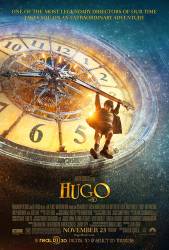Continuity mistake: A sheet of paper and an inkpot miraculously appear by the automaton right after Hugo winds it up.
Factual error: The scene showing Paris at night displays heavy traffic and bright car headlights over the distance. Both were not possible to be seen at time the story occurs, circa 1920's.
Revealing mistake: At the end of the first chase scene with Hugo, the Inspector and the doberman, Hugo escapes by climbing up and across a train trestle that goes over the tracks. In the overhead shot of Hugo going over the tracks, as he is walking, you can see a safety harness that is coming from his waist and to his left, attaching to a horizontal pole.
Continuity mistake: When the automaton starts writing it stops the first time with the pen tip over a small figure made of three blocks. The shot switches to a rear view of the automaton and its elbow moves all the way back to the starting position. The shot changes back to the pen tip and it is still over the small, three-block figure. This is impossible as moving the elbow all the way back would have moved the pen away from the drawing.
Continuity mistake: In the scene where the automaton stops drawing in Hugo's lair, in a close up there is a mysterious red spot on our right of Hugo's chin, but in the rest of the movie the spot is gone.
Continuity mistake: After Hugo and Isabelle see the picture of the moon printed on the book, their hands alternate between being on the book, to away from the book, between angles.
Continuity mistake: When the monkey-wrench falls, it lays on the middle of two tiles. When the angle changes, it lays on the center of a tile.
Continuity mistake: When Méliès shows up after the projection, the film suddenly disappears from the reel.
Revealing mistake: When the automaton starts drawing, a thick black piece suddenly appears behind the tip of the pen, most likely some sort of mechanism, or a piece of lead to allow for the drawing to be made.
Continuity mistake: When the automaton signs the drawing, it makes a dot inches away to the right of the "L". When Hugo hands the drawing to the lady, the dot is a thick mark right over the "L".
Continuity mistake: After Frick gives the Dachshund, the Inspector looks at his watch and puts it in his pocket. When the angle changes, he is looking at his watch again and repeating all previous movements.
Continuity mistake: After Hugo's been saved by the inspector, he holds onto the automaton while being threatened by the cop. Méliès arrives and shouts, and for a brief moment the way Hugo holds the automaton completely changes.
Continuity mistake: The first time the doberman dog chases Hugo, it enters a hallway and skids. The passers-by behind differ between shots.
Continuity mistake: After the inspector saves Hugo, he yells at him "What were you thinking of?" Hugo's hair is moving wildly in one angle, still in the next angle, then wild, and finally back to still.
Continuity mistake: After Tabard shows the movie, he raises up twice.
Continuity mistake: While the inspector flirts with Lissette, she is standing sideways or straight, depending on the angle.
Continuity mistake: When Hugo bumps into Labisse and the books fall, their position changes between shots.
Continuity mistake: When the drawings fly all over the room, the ones on the box's lid appear / disappear randomly between shots.
Continuity mistake: When Hugo gives Mrs. Méliès the drawing, her hands change positions between the wide and the close-up angles.
Continuity mistake: Position and number of drawings on the bed in Mr Méliès' house differs between shots.





